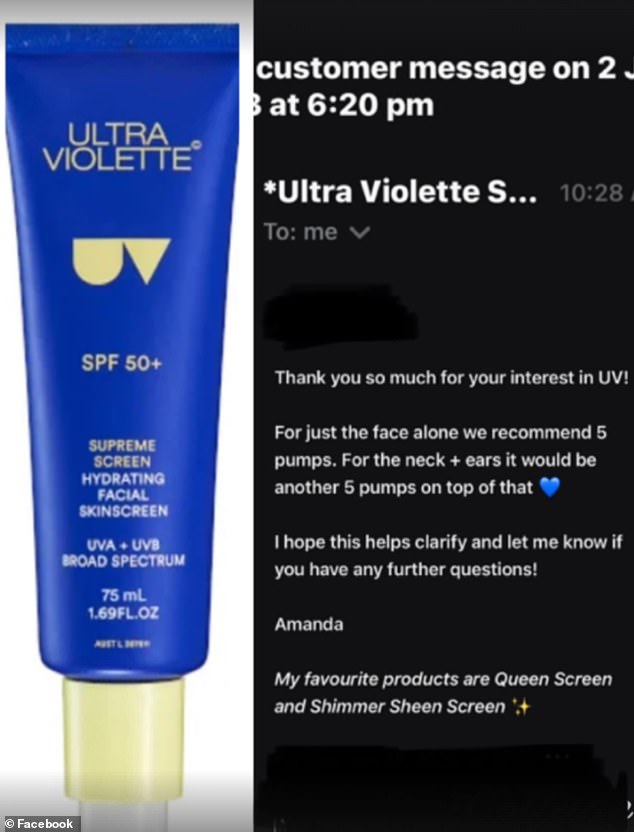This is the one sunscreen application mistake you're probably making - Shockingly simple way to get the best sun protection
By
- Replies 9
Using sunscreen on a daily basis is incredibly important for every Aussie, but particularly for seniors who are more susceptible to the harmful effects of the sun's UV rays.
And with an alarming four out of five Australians expected to be diagnosed with skin cancer in their lifetime, it’s never been more important to take the necessary precautions.
But here’s the thing - it turns out that most of us are probably making a big mistake when it comes to sunscreen application and not even realising it.
Ultra Violette, a popular sunscreen brand in Australia, recently advised a customer how much of their product she should use. And we have to admit, we were surprised!
One customer asked the company how much sunscreen they should actually apply to their entire face area, to which a representative responded by saying that they should apply five pumps of sunscreen to their face alone.
Additionally, for the neck and ears, another five pumps are required, bringing the total to a minimum of ten pumps of sunscreen to be applied.

The customer was surprised by the figure and admitted that he had been using much less than the recommended amount of sunscreen.
‘I've been using one and a half pumps thinking that's plenty, I cannot imagine using five pumps,’ the customer said.
They weren’t the only ones, as several others took to the comments section to share their confusion, with many expressing concern about the cost of their sunscreen routine if they used the recommended amount.
One woman shared: ‘I use two pumps for just my face. It would be such a thick layer with five and would be impossible to layer on top of.’
Another said if she was using five pumps, she would feel like a ‘grease ball’ and it would pill under her makeup.
Fortunately, not everyone was as doubtful of the advice. Some people claimed they use five pumps of sunscreen and love the finish it provides, adding that it looks and feels great.

So why exactly should we use five pumps of face sunscreen?
Ultra Violette co-founder Ava Matthews explained that five pumps of Supreme Screen is equal to a quarter of a teaspoon, which is approximately 2 mg of sunscreen per centimetre of skin — the recommended amount for applying it across the body.
That is because, according to tests conducted on sunscreen, a 2 mg per cm2 concentration appears to be effective in preventing ultraviolet rays from penetrating the skin.
'It's not an amount we pulled out of thin air, we're simply the only brand that says it,' Ms Matthews clarified.
'Our goal is to make it as easy as possible for the consumer to use sun protection.'
She also emphasised that customers might use a different product on their entire body and shoulders instead of Supreme Screen, which is a product designed particularly for the face.
Guide to choosing the best sunscreen for your skin
As seniors, it’s important to be sun smart and make sure you’re taking the right steps to protect your skin from the sun. That starts with choosing the right sunscreen for your age, skin type and environment.
When it comes to sunscreen, always choose a product that provides broad-spectrum protection against both UVA/UVB rays. Broad-spectrum sunscreen means it helps protect against both types of skin-damaging radiation in the UV spectrum.
For maximum protection, you also need to look for sunscreen products with an SPF 30+. SPF stands for Sun Protection Factor, and it indicates the degree of protection a sunscreen provides against skin damage from UVB radiation. Generally speaking, the higher the SPF, the greater your protection.
If you spend a lot of time in and around water, it’s important to choose a sunscreen that is water-resistant. Whilst no sunscreen can be considered waterproof, many are labelled water or sweat resistant, with either a 40 or 80-minute time frame. If you’re heading swimming, it’s best to pick the 80-minute option, but remember to reapply according to the manufacturer’s instructions to maintain its effectiveness.
When selecting the right sunscreen for you, it’s important to pick one that not only works, but also feels right. Sunscreen comes in a variety of formulas - lotions, sprays, oils, creams - and you should select a product that both suits your needs and your lifestyle.
If you’re active and outdoors a lot, you may prefer a spray sunscreen that is easy to apply and won’t be too heavy. If you have dry skin, you may want to opt for a moisturising cream sunscreen. Sunscreen is also available for allergies and sensitive skin, as well as for babies and children.
Folks, these days it’s easier than ever to pick a sunscreen that will last and keep your skin safe. Make sure you talk to your dermatologist or GP to get the best advice about sun protection for you.

There you have it, folks! We have to admit, we were shocked to find out that we've been applying sunscreen incorrectly all this time.
With all this information, we hope that it will be easier for you to apply sunscreen more effectively, folks! Please share this with your family, friends, loved ones, and even strangers because we want everyone to protect themselves from the harmful effects of the sun!
As always, comments, questions, and concerns are welcome in the comments section below! Stay safe, members!
And with an alarming four out of five Australians expected to be diagnosed with skin cancer in their lifetime, it’s never been more important to take the necessary precautions.
But here’s the thing - it turns out that most of us are probably making a big mistake when it comes to sunscreen application and not even realising it.
Ultra Violette, a popular sunscreen brand in Australia, recently advised a customer how much of their product she should use. And we have to admit, we were surprised!
One customer asked the company how much sunscreen they should actually apply to their entire face area, to which a representative responded by saying that they should apply five pumps of sunscreen to their face alone.
Additionally, for the neck and ears, another five pumps are required, bringing the total to a minimum of ten pumps of sunscreen to be applied.

A customer was instructed by an Ultra Violette representative to apply five pumps of their Supreme Screen to their face and five more to their neck and ears. Credit: Facebook.
The customer was surprised by the figure and admitted that he had been using much less than the recommended amount of sunscreen.
‘I've been using one and a half pumps thinking that's plenty, I cannot imagine using five pumps,’ the customer said.
They weren’t the only ones, as several others took to the comments section to share their confusion, with many expressing concern about the cost of their sunscreen routine if they used the recommended amount.
One woman shared: ‘I use two pumps for just my face. It would be such a thick layer with five and would be impossible to layer on top of.’
Another said if she was using five pumps, she would feel like a ‘grease ball’ and it would pill under her makeup.
Fortunately, not everyone was as doubtful of the advice. Some people claimed they use five pumps of sunscreen and love the finish it provides, adding that it looks and feels great.

Researchers that looked at how much sunscreen should be absorbed by the skin for the best benefits said that the recommended approximately 2 mg of sunscreen per centimetre of skin. Credit: Pexels/rf._.studio.
So why exactly should we use five pumps of face sunscreen?
Ultra Violette co-founder Ava Matthews explained that five pumps of Supreme Screen is equal to a quarter of a teaspoon, which is approximately 2 mg of sunscreen per centimetre of skin — the recommended amount for applying it across the body.
That is because, according to tests conducted on sunscreen, a 2 mg per cm2 concentration appears to be effective in preventing ultraviolet rays from penetrating the skin.
'It's not an amount we pulled out of thin air, we're simply the only brand that says it,' Ms Matthews clarified.
'Our goal is to make it as easy as possible for the consumer to use sun protection.'
She also emphasised that customers might use a different product on their entire body and shoulders instead of Supreme Screen, which is a product designed particularly for the face.
Guide to choosing the best sunscreen for your skin
As seniors, it’s important to be sun smart and make sure you’re taking the right steps to protect your skin from the sun. That starts with choosing the right sunscreen for your age, skin type and environment.
When it comes to sunscreen, always choose a product that provides broad-spectrum protection against both UVA/UVB rays. Broad-spectrum sunscreen means it helps protect against both types of skin-damaging radiation in the UV spectrum.
For maximum protection, you also need to look for sunscreen products with an SPF 30+. SPF stands for Sun Protection Factor, and it indicates the degree of protection a sunscreen provides against skin damage from UVB radiation. Generally speaking, the higher the SPF, the greater your protection.
If you spend a lot of time in and around water, it’s important to choose a sunscreen that is water-resistant. Whilst no sunscreen can be considered waterproof, many are labelled water or sweat resistant, with either a 40 or 80-minute time frame. If you’re heading swimming, it’s best to pick the 80-minute option, but remember to reapply according to the manufacturer’s instructions to maintain its effectiveness.
When selecting the right sunscreen for you, it’s important to pick one that not only works, but also feels right. Sunscreen comes in a variety of formulas - lotions, sprays, oils, creams - and you should select a product that both suits your needs and your lifestyle.
If you’re active and outdoors a lot, you may prefer a spray sunscreen that is easy to apply and won’t be too heavy. If you have dry skin, you may want to opt for a moisturising cream sunscreen. Sunscreen is also available for allergies and sensitive skin, as well as for babies and children.
Folks, these days it’s easier than ever to pick a sunscreen that will last and keep your skin safe. Make sure you talk to your dermatologist or GP to get the best advice about sun protection for you.
Key Takeaways
- An Australian sunscreen brand advised customers to use at least five pumps of their Supreme Screen on their face and another five pumps on their neck and ears.
- Not all sunscreens are created equal, and you should choose sunscreen with broad-spectrum protection against UVA and UVB rays, as well as SPF 30+ or higher and water-resistant sunscreen for swimming.
- Those who fly regularly have increased exposure to UVA radiation, and sunscreen should be applied every two hours while in the air.
- The general advice is to use one teaspoon of sunscreen per body part, and making sure you reapply regularly to cover any parts of the skin you may have missed.
There you have it, folks! We have to admit, we were shocked to find out that we've been applying sunscreen incorrectly all this time.
With all this information, we hope that it will be easier for you to apply sunscreen more effectively, folks! Please share this with your family, friends, loved ones, and even strangers because we want everyone to protect themselves from the harmful effects of the sun!
As always, comments, questions, and concerns are welcome in the comments section below! Stay safe, members!








